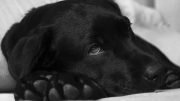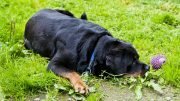The Hygen Hound or “Hygenhund” is an excellent scent hound, known for its dignified and equable temperament. The Hygen Hounds are hare hunting hounds, experts in trekking and retrieving. They are little known outside of Scandinavia.
The Hygen Hound got its name from the Norwegian procurator Hans Fredrik Hygen, who started breeding scent hounds in Eastern Norway in 1830 and later in 1839 moved to the region of Romerike, eventually adding the selected variety from the area into the breeding program.
According to the Illustrated Guide to Dogs, a book by Joan Palmer, the Hygen Hounds have been bred from the so-called “Ringerike Hounds,” which were once an old and local Scandinavian hound breed.
A.B. Hygen became one of the founding members of the Special Club for Norwegian Scent Hounds in 1902 and was centrally involved in the creation of breed standards.
In the same year, the Hygen Hound was recognized as a separate breed.
The Hygen Hound breeding struggled during the years before and after World War I. Between 1925 and 1934, despite being clearly opposed by the Special Club for Norwegian Scent Hounds, the Norwegian Kennel Club integrated the Hygen Hound with the Norwegian Hound and called both breeds “Norwegian Hare Hounds,” due to the former’s limited number.
Prior to World War II, the number of Hygen Hounds led to the Hygen Hound being acknowledged as a distinct breed once again. At the end of the war, the Hygen Hound breeding was in a good phase, and the breed progressed.
According to the information by the Swedish Kennel Club and the Norwegian Kennel Club, in an effort to obtain additional breeding males and to widen the breeding line for the Hygen Hound, other breeds have been paired with the Hygen Hound.
In the 1970s, some Norwegian Hound blood was included in the mix. From 1976 to 2012, they have been crossed together 6 times. They have also been crossed twice with the Finnish Hound and once with the Hamilton Hound.
The Norwegian Kennel Club has been registering between 27 and 44 Hygen Hounds annually over the last few years. A total of 457 Hygen Hound puppies have been born and registered from 2000 to 2012.
However, the population is still extremely low, and the overall goal is to maintain them with a broad breeding basis and to ensure the future for the breed without the risk of the unfavorable effects of inbreeding.
According to an article by newspaper Aftenposten in 2012, the Hygen Hound has been listed as one of the 6 Norwegian dog breeds at risk of extinction.
The Hygen Hound
According to the Swedish Kennel Club and Norwegian Kennel Club descriptions, although the Hygen Hound seems to carry a resemblance to the Norwegian Hound, the Hygen Hound is strongly-built and fairly shorter than the Norwegian Hound. The Hygen Hounds have also preserved the color of the Ringerikes.
The Hygen Hounds are medium-sized and short-coated, rather long, and have a solid and compact profile. They have an average life expectancy of 11 years. Height for males is around 50-58 cm, and ideally 54 cm; while for females it’s47-55 cm, ideally 51 cm.
They have dark brown eyes, a strong back, and a very slightly tucked up belly.
Their face is almost wedge-shaped and unpointed, in a calm and earnest expression. Their ears hang away from the cheeks with tapering rounded tips.
Their moderately broad, deep, and spacious chest and well-developed ribcage give them a long appearance.
Their coats are straight, dense, and shiny. They are observed in three evident color types: red-brown or yellow-red, and some black shading on the head, back, and tail, with or without white marking; black and tan, normally blended with white marking; and white with red-brown or yellow-red speckles and strokes, or with black and tan patterns. The most common Hygen Hounds are those with a reddish base.
The dogs are trainable, hardworking, calm, and friendly in nature, with an eagerness to learn. They make for great family dogs.
However, they have an obvious inclination to hunt and chase at early stages and have a distinctive resonating tone.
They are a healthy breed and do not tend to have any major health problems or dangerous diseases, with the exception of epiphyseal dysplasia (a rare condition) and minor occurrence of allergies, tail cracks, and reproductive problems.
Source: #Norway Today
Do you have a news tip for Norway Today? We want to hear it. Get in touch at [email protected]



Leave a comment